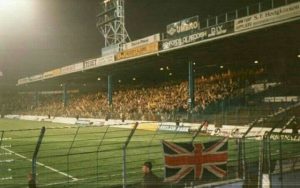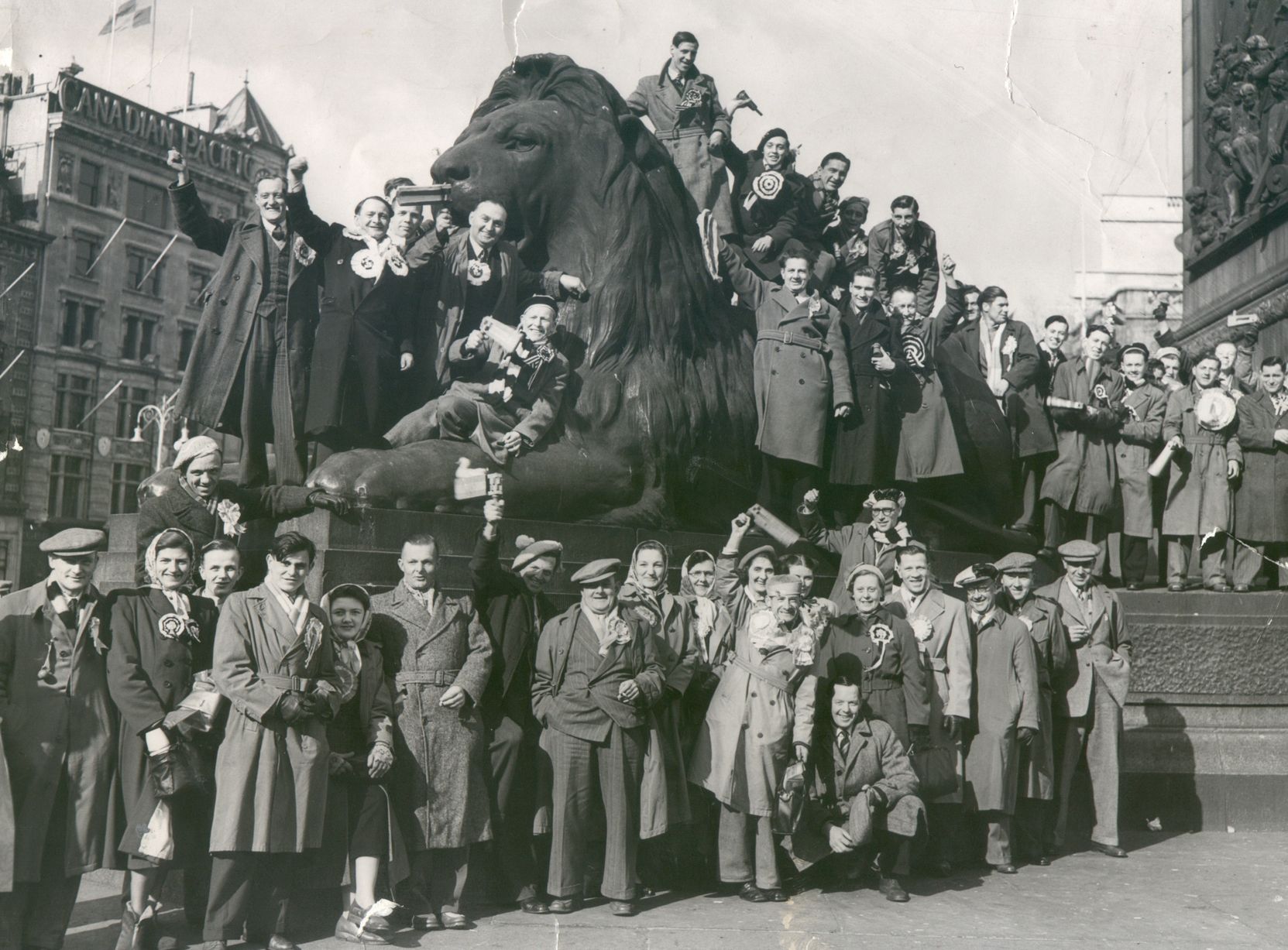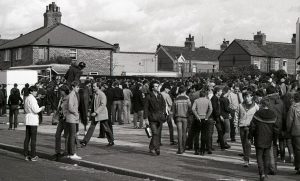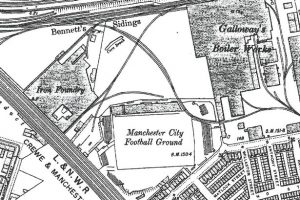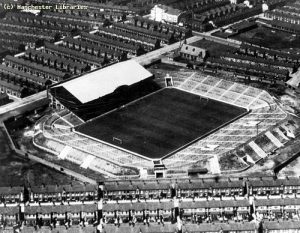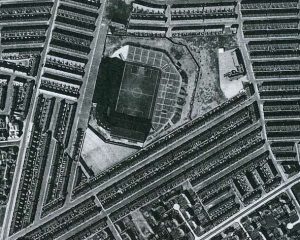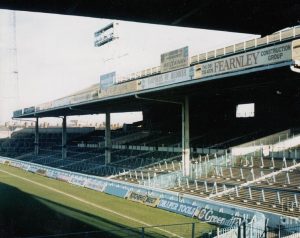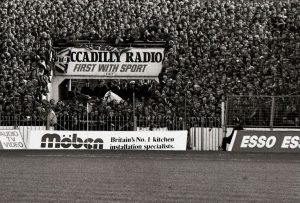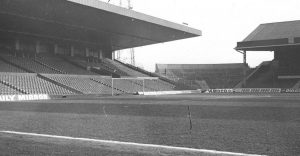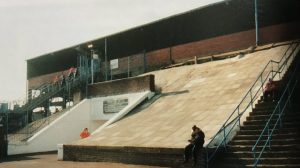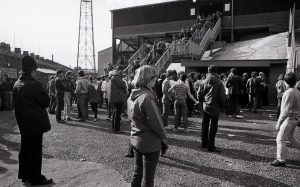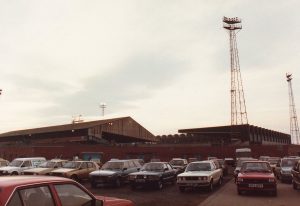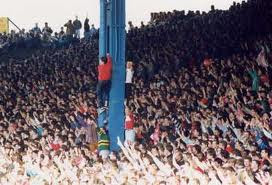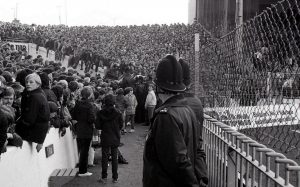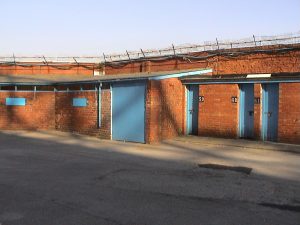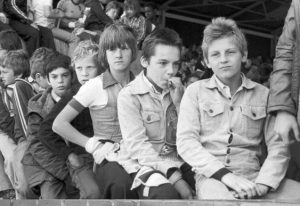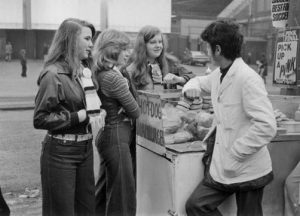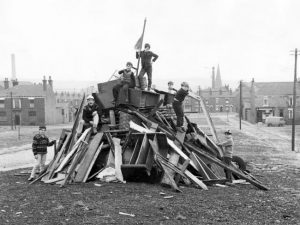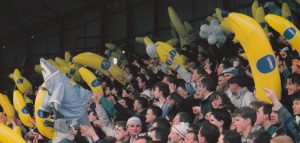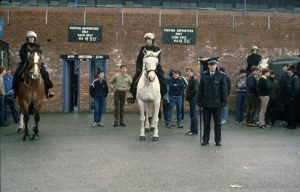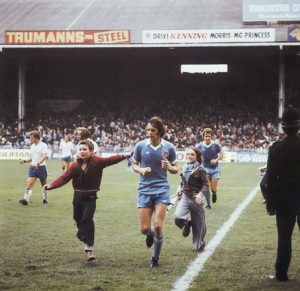
Playing down at Maine Road
It’s impossible to separate Maine Road from Moss Side, in history or in memory. The story of one is the story of the other. That was not always a positive thing, because in the ground’s later days the Moss didn’t have a good reputation. But the stigma had an ambiguous quality: many, many decent people lived good lives in the area, and many City fans enjoyed visiting. As former Superintendent Robin Oake commented following the summer of 1981 that brought two days of looting, firebombing and anarchy, “The riots were out of character. Moss Side was one of the happiest places I ever policed.”
Moss Side’s redbrick terraced streets went up around the turn of the 20th century. City moved there in 1923, when the lease on their cramped ground at Hyde Road expired. They were looking for a larger site to accommodate their growing support base, and the former brickworks opposite Maine Road – recently renamed from Dog Kennel Lane – was ideal. It gave City enough space for a huge 10,000-seat stand, a ground that was soon breaking attendance records, and a sizeable car and coach park to accommodate the increasing number of fans travelling by excursion.
‘The finest equipped ground of any club’
Nowadays people often refer to new-build stadia as “bland”, “identikit”, “soulless” and so on. I suspect this was also the case in the early years of grounds we now regard as iconic, because in their own way they too were pretty homogeneous. Back in the day, your money generally got you a stand and three sides of terracing. All the greats – Highbury, White Hart Lane, Old Trafford – started off this way. The ornateness of the stand depended on your club’s wealth and pretensions, but the terraces were invariably knocked up on the inner slope of spoil heaps created when the pitch was excavated. The bigger the hole, the bigger the terrace. And City’s new 88,000 capacity home at Maine Road created an impressive hole.
It was an indication of the venue’s status that supporters accessed Maine Road’s terraces – in those days a cinder step supported by a wooden nosing, rather than the concrete of later years – not just via staircases, but also by tunnels from open concourses at the rear. Stairs were commonly built into the back of a terrace mound in the same way as viewing steps were built into the front, but access tunnels were a significant refinement. City’s were deliberately prominent, dominating the ground’s appearance from inside as well as out. In this respect Maine Road strongly resembled Old Trafford, three miles to the west.
The stadium was known as Maine Road because that was the location of its front entrance, beneath the tiled fascia of the Main (not Maine) Stand. The address “Maine Road, Moss Side, Manchester” became a famous one. The North End was a similarly obvious name for the terrace to its left. But the popular titles of the remaining two terraced sides owed less to logic than to the routes fans used to get to them. The southern end, which actually faced the back of Thornton Road, became known as the Platt Lane after the rather broader thoroughfare that links Wilmslow Road and Princess Road. And the long side opposite the Main Stand, although it ran parallel to Yew Tree Road, was instead eventually named for the unremarkable terrace that led to its top corner – Kippax Street.
The Kippax
As with all our lives, the Kippax was defined by particular events at particular times. No doubt it gained favour with fans in the early days for no more reason than you could, for a fraction of the price, get the same view as the great and the good in the Main Stand. But three things created a special identity. First, in 1957, it gained a roof and concrete terraces (the “Kippax” name dated from this era). Then, in 1963 and 1970 respectively, the construction of seated stands at the Platt Lane and North ends left this side fully defined as the ground’s only terrace – and on days when it was full, that meant 30,000 people swaying, roaring and experiencing a full range of emotions in a space not much bigger than a couple of terraced streets.
In later years that capacity was reduced – on safety grounds, but also to allow for the separation of rival fans. By the late Seventies, away supporters were being contained, in principle at least, in the Platt Lane corner (sometimes called Piccadilly Radio Corner after their big advert over the tunnel there), and in one of a number of terrace sections under the southern end of the roof. The two sets of fans, kept just yards apart by railings, could hurl abuse and missiles at one another throughout the game and from their respective staircases on the way out, following which exchange of pleasantries there was usually a coming together in the forecourt and a fraught journey back to their transport for the visitors. For games against United this degree of control was aspirational at best.
Piccadilly Radio Corner was lower than the main Kippax, due to the elliptical shape of the stadium’s original design (the side terrace, previously the long side of the ellipse, was squared off to accommodate the roof). Although uncovered this corner did receive some shelter from the adjacent Kippax and Platt Lane roofs, whereas the opposite one was known as Windy Corner due to its exposed position next to the lower North Stand. On this wedge of terrace, in autumn 1987, the inflatable craze was born when City fan Frank Newton removed his replica shirt during a game against Plymouth and put it on a blow-up Fyffes banana.
Originally there were six staircases – two at Windy Corner, a small one next to the Platt Lane tunnel, and three accessed via openings in the rear fence of the roofed section. One of the Windy Corner pair was removed when the North Stand went up in 1971, and the access tunnel in that corner was blocked up at the same time. Two of the three rear staircases were reprofiled following the Ibrox disaster, also in 1971. The middle exit was covered over, but the steps behind the stand remained in situ and became a popular place for fans to congregate, not least because they overlooked the visitors’ enclosure. (For this reason the banking here was covered with paving slabs, making it harder to climb and less promising as a source of ammunition).
The modified staircases were only a limited success, and the crushing around the Kippax exits remained notorious among the fans who stood there. You would sway for what seemed like ages, a cork in a human sea, feet off the ground – and then, suddenly, be propelled through the opening into an orderly trit-trot down the steps. And occasionally you wondered what would happen if someone slipped, or if the barriers weren’t as strong as they seemed.
Our Kippax routine was to walk along Claremont Road via either (or some/all of) the Clarence, Welcome, Lord Lyon and Sherwood, then turn down Yew Tree Road and go in at the North Stand end. From a distance Maine Road’s tall floodlight pylons and the white Main Stand roof dominated the Moss, but once you entered its narrow streets this perspective was lost until you turned into the car park itself. Here, the turnstiles were in an outer wall, with all the essential in-ground amenities – pie stand, beer bar and some quite horrific toilets – in an inner courtyard.
Once in the ground the story really began. Everyone has their own. These are reproduced with thanks to www.bluemoon-mcfc.co.uk and www.thedaisycutter.co.uk .
A mass of joyous blue squashed-upness
“The songs would start a good hour before kick off and I can’t think of an away support that we didn’t drown out and take the piss out of mercilessly.”
“The best days were the derby games, in extra early and the whole length of the Kippax alive and buzzing with excitement. As the ‘If you hate Man Utd clap your hands’ chant started I would turn to my right and the whole stand would have their hands outstretched in the air waiting to clap in unison all the way through to the corner flag where the Kippax ended.”
“There was a guy who was blind, who used to go in with his mate as he enjoyed the atmosphere in there more than in the seats. His standard line was ‘Fucking hell ref, even I could see that was a foul.’ ”
“The roof leaking, the heat haze rising when goals were scored on cold days. The strange signs in the back of the stand ‘Commit No Nuisance.’ “
“Anyone remember the tiny hut bar behind the Kippax at the Platt Lane end? Before they put in the away fans’ segregation a crowd of us used to stand right where they put the fence. We called it the Tunnel Bar (it was right by the exit tunnel) and at the half-time whistle we’d dash out to grab a couple of beers. There was rarely a queue and it seemed like hardly anyone knew it existed. Mind you, they only had bottled Greenalls and it was crap.”
“As I was walking out past ‘no man’s land’ a full pie comes flying over and skims the top of my head, leaving a fair amount of flaky pastry in my spiky (I had short hair back then) hair. Glad it wasn’t an inch or two lower as I wouldn’t have fancied scraping mince meat off my fizzog (no danger of scalding as the pies weren’t that warm).”
“My worst memory was being taken short and having to use a cubicle in the bogs near the turnstiles at the back of the Kippax. They were absolutely vile, but I had to go. The experience haunts me to this day.”
“There used to be mud banks behind the Kippax. In 1971 in the Cup Winners Cup semi-final v Chelsea second leg which we lost 0-1, I can remember cops on horses riding up them and whacking fans with their batons.”
“Always arrived at least an hour before kickoff and loved being able to wander about freely down the front. But the biggest memory I retain was that wonderful surge forward after a goal, especially when the stand was full to bursting – the exhilaration of being swept up in a mass of joyous blue squashed-upness. Happy days.”
“Coppers on raised platforms at the back of the Kippax, and the deadly steep steps (later covered by the rebuilt “safe” exits in the late 70s).
“I’m still traumatised after using those bogs at the back of the Kippax. You needed wellies and a gas mask just to point Percy at the porcelain. Glad I never needed a dump, doubt I would have survived the ordeal.”
“My memories of the Kip are mixed. Some bloody good days and nights when the place was full and we were doing OK, the Etihad will never match those atmospheres. Completely different when the place was half empty and having to listen to miserable old buggers talking about the good old days.”
“At derby matches in late 60s/70s, bottles hitting the girders and shattering over opposing fans. Big corridor of no man’s land between them.”
“Kicking the gate in the alley at the back of the Kippax to wind the mad dog up.”
“Still chancing it for half price through the ‘schoolboys’ entrance, age 21.”
“All my kids having a teddy bear called Kippax.”
“I routinely came in via the Kippax car park from Yew Tree Lane with my pie, chips and gravy. The noise when we scored, the surge of people pushing you forward, used to shit me up at times. Going for a piss against the wall at the back. Dodging the horse shit on the way out and the occasional bottle.”
“Giant bags of chicken flavoured SMAX (orange bags) and wow was they dear, 35p, bought from the bloke with the white dentist coat on and the bread basket thing strapped around his neck from the front of the Kippax.”
“On busy days in the Kippax, lads would stand on the fence right at the back – you could almost touch the roof. I was looking for a space there one game, but as I walked along I saw that everyone up there had a massive hole in the bottom of their trainers from the spikes in the fence. I soon changed my mind!”
“Realising at the age of nine, in 1974, that “Covonia kills coughs”, and that if I had any spare steel it had to go to Trumann’s. The men in white coats selling drinks and pies along the front wall from a wooden tray.”
“Seeing the plastic hawk hanging from a piece of string in an attempt to scare the pigeons. Dodging darts, sharpened coins – and bangers when it was near bonfire night. Reading the scores against the letters at half time for the old boys who couldn’t read them.”
“Having the arm ripped off my Harrington when Kevin Reeves scored against Liverpool in the League Cup semi in 1981. The ref disallowed it, for what we’ll never know.”
“During quiet periods of the many boring matches, out of nowhere a single cry of ‘Rangers’ or ‘Celtic’ which would lead to the whole terrace being split into one-word chants of support for either of the two.”
“Bananas, gorillas, sex dolls, dinghies and anything else you could inflate.”
“That incredibly dim orange light during night matches from the 40w bulbs hung from the girders of the roof.”
“Running back up the tunnel or the stairs if you’d left early and we had scored a late goal. I don’t know what we thought we’d see when we got there, but we always went back!”
“Being in awe of the ‘faces’ and the fans with their Wrangler jackets covered in sewn on City badges.“
“Sunshine Corner we used to call it. We would occasionally stand there early in the season when the weather was good. A game I particularly recall standing there was against United when we were champions and they were European champions. I remember watching all the bricks and bottles flying from one end of the Kippax to the other. That was a day I was glad NOT to be in the Kippax.”
“Pintpots of piss being knocked over and running down the terracing.”
“Being jockeyed by police horses as you waited to reach the turnstiles. The sparks from their hooves.”
“My brother used to work in one of the bars in the Kippax during the mid ‘80s. Him and the other lads used to take their own boxes of Oxo so they could sell the Bovril and pocket absolute profit. Used to make a fortune. Me and my pals used to get sorted for free pies, although I wouldn’t consider that a perk!”
“The buzz of seeing the floodlights on for night matches as the bus trundled down Princess Parkway.”
“Night matches, rain pouring down, freezing cold as there’s five minutes to kick off and you’re still on Platt Lane. Catching a glimpse of the floodlights as you nip down the alleyways then, as you get closer, the chanting on the Kippax draws you in. Through the turnstiles and its dark again, as you head down the left hand tunnel, kicking empty cans and slipping on half-eaten burgers.”
